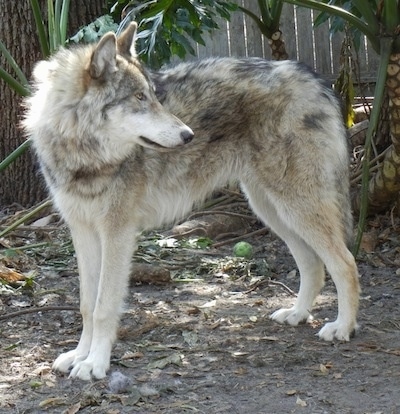
"Captain is a high content wolfdog. He is curious but very fearful/timid which is very common in true high content wolfdogs. Like other HC's he does not make a good house pet due to destructive tendencies. Getting a high content to be acceptable indoors takes a long time and is not very common. The first 3 pictures are of Captain around 8 months old in winter coat prior to his first shed. The second two are of Captain after his first shed at 1 year old. High content wolfdogs are only born during the spring as they only have one heat cycle per year. Often mid contents have only one cycle a year as well."
woolf dawg
Wolfdogs can better be described as companions than pets. They are smarter than most "domestic" breeds of dogs, are self aware, aware of their surroundings, will challenge even the most experienced caretakers with their stubbornness and "what's in it for me" attitude, and in general are the most predictable canine as wolves are the model for canine behavior and wolfdogs tend to display emotions very well.
The general layout for wolf content is 1-49% is considered a Low Content (LC), 50-74 % is considered a Mid Content (MC), and 75% + is considered a High Content (HC) a High Content may have 1-3 dog traits but otherwise should be virtually indistinguishable from a pure wolf.
Of course there are subdivisions of the normal classifications which overlap such as Low Content, Upper Low, Low Mid, Mid Content, Upper Mid, Low High, High Content, and Wolf Content are used to describe the animal. These terms are generally used in rescue when an exact genotype is unknown. A genotype is an animal’s % based on VERIFIABLE lineage. Verifiable lineage is NOT CKC papers as any animal can easily be registered with the CKC and the CKC does not check percentage. Many unscrupulous breeders will use CKC papers in an attempt to verify their animal’s lines.
Phenotyping:
Phenotyping is a way to help determine wolf content for either animals with unverifiable lineage or to help determine if a breeder is misrepresenting their animals (such as calling no/low contents high contents). A high content will never look and act like a dog, it’s impossible. A mid content will have an even number to slightly more wolf traits than dog traits. A low content will have less wolf traits than dog traits.
Checklist, the more wolf traits an animal has the higher the content. However remember that a few traits does not necessarily mean wolf content as dogs and wolves share a number of similar features and it is only a cumulative amount of traits that is able to determine wolf content through phenotyping.
Wolf Traits:
Adults: Narrow Chest (front legs should be almost touching or even touching when standing still) , Large Feet, Webbed Toes, Long Muzzle, No stop (point between forehead and muzzle, should be gradual slope), Black or Taupe toenails (never clear), V-Cape, Banded fur (single strand of fur should be multiple colors), Straight Tail, Bristled Tail, Black Tipped Tail (except for arctics), Front feet turn outward slightly, Cow Hocked, Lanky (long legs), Slanted Eyes, Black Rimmed Eyes, Black Nose, Black Lips, Eye Color (Yellow, Grey, Brown, Green, Amber) blue is extremely rare in high contents, Blended Coat, Blended mask, Small Ears, Rounded Ears, Well Furred Ears (no pink showing through), Single Track
At Birth/Babies:
Born dark brown/black and phase into their colors over time (some high contents may have one or two in a litter born white with line breeding, in breeding, genetic defect, etc…), No Prominent Markings at birth (should be a solid color with little deviation), Ears should be up and stay up at 3 weeks.
Depending on wolf content temperament can vary greatly. Both the wolf personality and the domestic dog personality should be taken into account if you are interested in a wolfdog.
High Content Temperament: High content wolfdogs tend to share most of the same personality and physical features as wolves. As such high content wolfdogs are often very fearful, preferring to hide from any stranger, they are NOT protective, you may get one or two warning barks/chuffs/howls to let you know there is a stranger present before the animal retreats.
Daily handling starting as early as 10 days old by direct family is vital; remember pups (both wolf, wolfdog, and dog) are very susceptible to disease at this point and interaction with people outside of the family can pose a health hazard. “Human handlers must begin contact early, preferably between 10-14 days of the pup's birth. Research has demonstrated that if a pup is not handled during the critical bonding period of its first 21 days, it may respond with very fearful behavior towards people and in captivity.” Handling must continue to prevent a lapse in socialization.
A second period of critical bonding occurs at 6-8 weeks.
Between six and eight weeks of age, a pup’s willingness to approach and make contact with strangers outweighs his natural wariness. This time frame is considered the optimum period to introduce a pup into its new home and surroundings. New studies, however, suggest a shorter time frame—7 ½ to 8 weeks (Serpell & Jagoe, 1999; Slabbert & Rassa, 1993; and Fox and Stelzner, 1966).
During this phase, a pup should be gradually exposed to potentially frightening stimuli such as kids, the postman, vacuum cleaners, spray cans, street noises, loud noises, etc. Between eight and twelve weeks of age, the pup should also be introduced to the places, circumstances, and conditions that he is likely to have to face as an adult. Not only do pups form attachments to people during this sensitive stage, but also to places.”
High contents are extremely intelligent and will test your containment. Unless you have a six sided kennel which is all 4 normal sides of a fence plus a top and bottom made of heavy duty chain link or cattle panels there is no such thing as bomb proof (and even then a wolfdog may find a weak point such as a rusted or damaged area).
For the most part with high contents, there is no such thing as a “house dog”. While there are people that have had success with bringing high contents into the home it is not the norm and they often can’t leave the animal unattended. This is because the term of an animal “eating you out of house and home” comes into play. In this case we are NOT talking about food. It is not unusual for a high content to chew apart your furniture, chew the drywall in your house, chew wires, chew doors, chew the outside siding of the house, whatever they can get their mouth on. Other unacceptable behavior often seen in high contents is jumping on tables, furniture, and sometimes even the top of fridges.
High content wolfdogs are the least likely to want to please you. Although very loving they are not likely to perform tricks, sit when asked, stay, rollover, etc... unless there is a trade worthy of their time (ie food/treats) and even then that may not work.
Because of a high prey drive young children, cats, or small dogs should NEVER be left alone with a high content wolfdog. A child running around screaming is likely to invoke a high prey drive response and can lead to injury or even death. Please note that this is not solely a wolf trait, other breeds of dogs (especially northern breeds) tend to have a high prey drive as well. Even with early socialization to cats or small dogs a high content should really never be left alone with either.
Mid Contents Temperament: Mid Contents tend to be more social than High Contents. They can take time to warm up to strangers and be very fearful at first but with patience they tend to trust much more quickly. A poorly socialized mid content is less likely to become “feral” than a high content with the same lack of socialization. With good breeding mid contents can be outgoing but many will retain some kind of shyness around strangers. Mid contents can often be brought into the house although chewing may be a problem, they do tend to be more willing to please than high contents.
Mids are in general better with small animals than high contents but since often times wolfdogs are mixed with Northern breeds, GSDs, Border Collies, or other breeds with high prey drive any owner should be cautious when they are around young children, cats, or small dogs. Mid contents also can be destructive.
Low Contents Temperament: Low contents are the best choice for someone new to wolfdogs. They are often the most outgoing, willing to please and best in the house while often retaining the intelligence and self awareness of a high content. Low contents are easy to train albeit they can be stubborn at times. Low contents are also the most likely to do well with children, cats, and small dogs. However cats tend to still be viewed as prey. Early socialization can help to eliminate most risks.
Also remember that breeding that does not take temperament into account can result in an animal that is unstable (certain breeders are known to have aggressive wolfdogs or wolfdogs with behavioral issues). This isn’t necessarily due to the “wolf” in the animal but because aggressive animals have been bred further promoting poor behavior in offspring.
Instability is not necessarily due to breeding 'aggressive' wolfdogs per say. What often times happens is a mis-match of temperament in the dog breeds chosen to cross with a wolf. For example some German Shepherd working lines have an inherent genetic make-up toward aggression, protection and/or assertion. That is why, with proper training, they make excellent police or protection dogs. If you mix this temperament with a wolf's shy, witholding temperament, the wolfdog will be more unstable because of the internal conflict created by these two opposing genetics. Some times the wolfdog will withdraw and sometimes it will aggress, always with unpredictability. In one situation the wolfdog may not react. Then in a later very similar situation, the wolfdog may try to aggress. You won't be able to predict future behavior by past behavior. This propensity cannot be 'trained out of them'. The unprovoked 'snapping' between shyness and aggression will be possible and more unpredictable regardless of the 'content' of the wolfdog, because of the breed it was mixed with. This is an unfortunate consequence of uninformed, careless breeding. The wolfdog pays the price with it's life when it is then labeled 'vicious'.
Average: 26-34 inches males & females equally. The lower content wolfdogs tend to be on the shorter side, while the higher contents tend towards the taller side.
Wolfdogs' average adult weight goes from 60 to 120 pounds, but getting that high is fairly unusual and tends to be males in winter coats. Claims of anything much more than that are no doubt false information or exaggeration.
In general wolfdogs are exceptionally healthy animals. They do not have any common genetic health problems such as hip dysplasia, etc, but can of course be bothered by common canine ailments such as fleas, ticks, heartworms (if not treated with preventative); canine diseases such as parvovirus, distemper, rabies, etc which should be vaccinated against like any other dog; and other illnesses such as kennel cough, coccidia, giardia, etc. Note that some veterinarians will not treat wolfdogs of mid and/or high content, so be sure to call your local clinics to check before adopting.
This is where things can get very expensive. Low’s and many mids can live in a normal fence. However, high contents often require 6-8 ft fencing, lean-ins, diguard, and hotwire to prevent escaping. A bored animal is an unhappy animal and more likely to attempt to roam. There should be no beams on the inside of the fence that would provide a foot hold, the fencing should be cattle panels or heavy duty chain link (wolfdogs have been known to bite through weaker chainlink), or even vinyl fencing. Wood is not recommended because it eventually degrades and poses an escape risk once its begun to rot/weaken. Mids and High Contents are the most likely to attempt to escape; sheer height is not always enough as a wolfdog can literally climb out of a chain link/cattle panel fence. Until your animal is older you won’t really know if they will be an escape risk.
There are some high contents that can be easily contained and low contents that are escape artists. It just depends on how bad your animal wants out, if they are bored, if there is something on the other side of the fence that is really exciting them, etc…
Note: Wood and vinyl fencing can be at risk of being chewed apart.
A large fenced in (NO wireless/inground electric fencing) enclosure is ideal where he/she has enough room to run and play. Wolfdogs are also very social animals and should always have at least one other canine companion.
Wolfdogs of all content levels require a lot of mental stimulation as well as physical exercise. Some of this can be done in their enclosure by playing games with them. Wolfdogs needs extreme amounts of exercise. A "rest day" is at least 3 hours. A normal day should be at least 5 hours of activity of running, search training, pulling sledges/carts. Most are able to be walked on a leash like any other dog, and should be walked every day, ideally. High contents can sometimes be fearful in some walk situations and may do better in rural walking areas vs suburban. It is not recommended to have a wolfdog in a city-type environment. A wolfdog's enclosure must be very big (minimum 20x20' for 1-2 animals) and should have places to hide and take shelter, objects to climb on (not close to the fencing!), toys, etc. Frequently bringing in new forms of enrichment is key to keeping a wolfdog happy and healthy.
Note: A wolfdog should be walked with two leashes. One attached to a collar or harness and the other a slip leash. The leash attached to the collar/harness should be the main leash, the slip lead is to act as a backup if something spooks the animal, because if they slip out of their harness/collar while panicking they are likely to bolt off which puts them at risk for getting lost, getting impounded by animal control, being hit by a car, etc...
About 13-16 years
About 4-6 Puppies
Wolfdogs have a double coat which becomes very very thick during winter months. This allows them to be comfortable outside just as their wild relatives are. They "blow" their winter coat (lose all the under coat) in spring and at this time a lot of grooming is needed. "Rake" style brushes are very useful for this. Otherwise general brushing every couple of weeks is usually sufficient. Keep a closer eye on tail fur and fur behind the ears as these areas are the most likely to become tangled.
Wolfdogs came about via crossing pure wolves bred by fur farms with similar looking dogs (ie: Malamute, GSD, Husky-types). They are never created by leaving a female dog tied up outside in wolf territory, nor by using wolves that were "den robbed" as pups. Most wolfdogs are bred "wolfdog x wolfdog", but some are still bred "wolfdog x wolf" or for the low - mid contents "wolfdog/wolf x dog". As a rule of thumb, the higher the filial number (or F#), the easier to handle the animal will be. For example, a pup from a pure wolf and wolfdog (or dog) mating would be called an F1. If that animal was later bred to another F1 animal, the resulting pups would be F2, and so on. The number indicates how many generations away from a pure wolf an animal is.
Wolfdogs are mixed breed dogs and as such cannot be registered with ANY reputable kennel club, such as the American Kennel Club. There are some online registries that will provide papers for them for a fee, but these are online scams - buyer beware. There are a few wolfdog fanciers groups/clubs, the most common being the Florida Lupine Association.
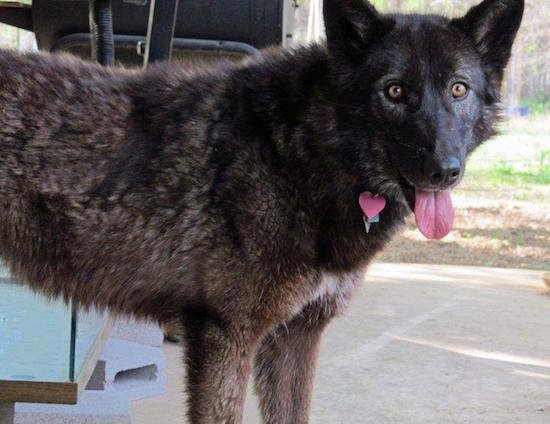
Kyra, a mid content wolfdog at 3 years old
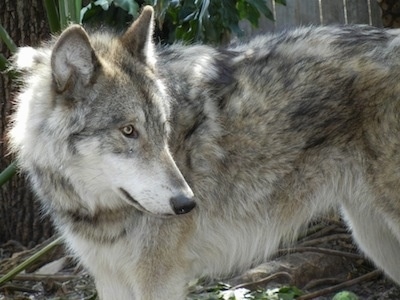
Captain a high content wolfdog.

Shango is a high content wolfdog. He does outreach and education and is an ambassador for his breed.
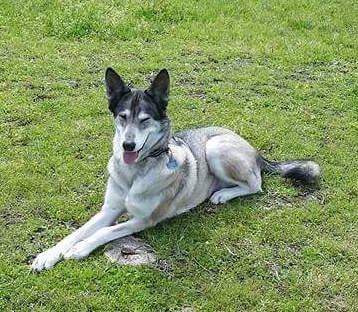
"Kyla the Wolfdog at 7 years old. She is 44% Timberwolf, 25% Tundra wolf, 25% American Akita and 6% German Shepherd Dog. I bought her and brought her home at 4 weeks of age. She had very early socialization, training and housebreaking. She is extremely social, protective of real threats, does great in packs. She does not do well with small, aggressive, barking dogs. She has been the most challenging dog I've ever had in regards to training and behavior modification, yet the most rewarding of all! She is my true companion and ETA. She has the ears and tail of the Akita in her, as she does curl her tail like Spitz breeds and ears are larger than the gray wolf type. She is very predatorial."
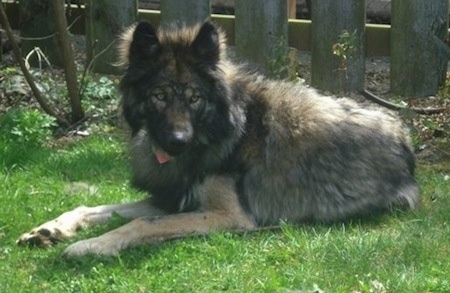
"Tala the wolfdog (Gray Wolf/ Malamute/GSD). She is showing a slightly longer coat than a wolf (Malamute genes) and quite a lot of German Shepherd type coloring which are dog genes, but she still has almost no "stop" (the point at which the muzzle meets the forehead), has very well blended color (ie: no husky mask with strong demarcation), her eyes are set at an angle into the face (and yes, are yellow - but there *are* dog breeds with yellow eyes also. Blue eyes will not occur in wolfdogs over low content. Her nails are exceptionally thick and black almost like claws. She has long legs, a very narrow chest, very well furred smallish ears, black tipped tail, cowhocked back legs, enormous feet, and is very tall (wolfdogs are around 26"-34" at the shoulder). Those are all wolf physical traits. She is not shy due to extreme socialization from an early age, but many are shy. I have included pictures of both winter coat and summer coat for comparison. Wolfdogs tend to be master escape artists and are exceptionally destructive in a home or vehicle. They usually do not travel well at all. They require outdoor containment similar to a zoo and cannot subsist on anything other than raw meat or high quality grain-free kibble. They also usually live to about 16+ years of age, so please consider all these things before looking for a breeder."
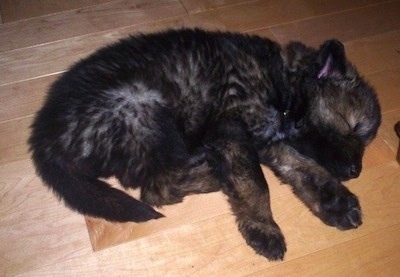
Tala the wolfdog (Gray Wolf/ Malamute/GSD) as a 4 week old puppy.
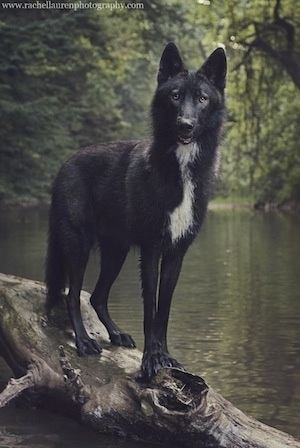
"Lucian is my Upper Mid Content Wolfdog. He is easier to manage than a High Content animal, but for those who have no previous wolfdog experience he would pose a challenge. Volunteering at a local wolf or wolfdog sanctuary, or meeting someone with one of these animals can help give someone experience. I worked with High Content Wolfdogs for several years before I felt fully prepared to bring Lucian into my home. Wolfdog ownership is not to be taken lightly!"
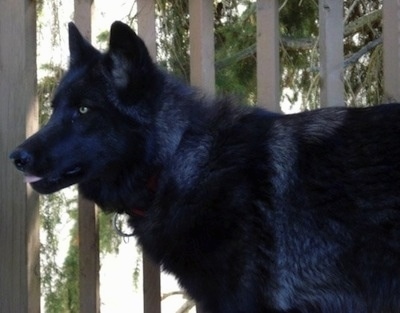
Varg a black-phase upper mid content wolfdog.
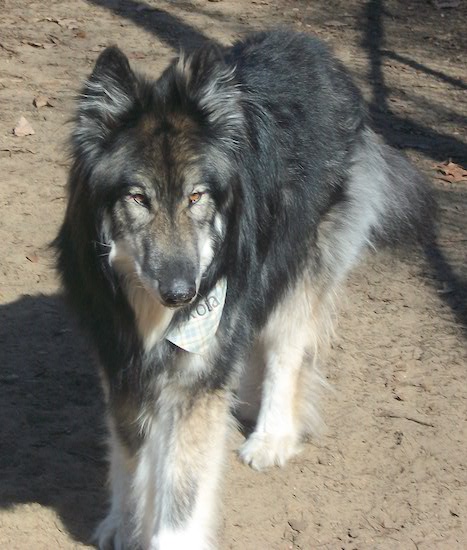
Lakota is a mid content wolfdog shown here at 9 years old.
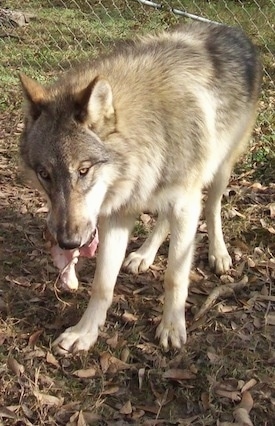
"Ayashi is a well bred, high content wolfdog from Winddancer wolves in Ohio. she is 2 years old and is still very playful and acts like a puppy. She can be dominant with other wolfdogs at times, but she will also roll over and show you her tummy the moment she sees you. she loves most people and loves the water. notice her slanted eyes, well furred ears, long legs, giant feet, coat that is blended, and her hanging tail. all things that make her my wolfy girl. i love her and am blessed to have her."